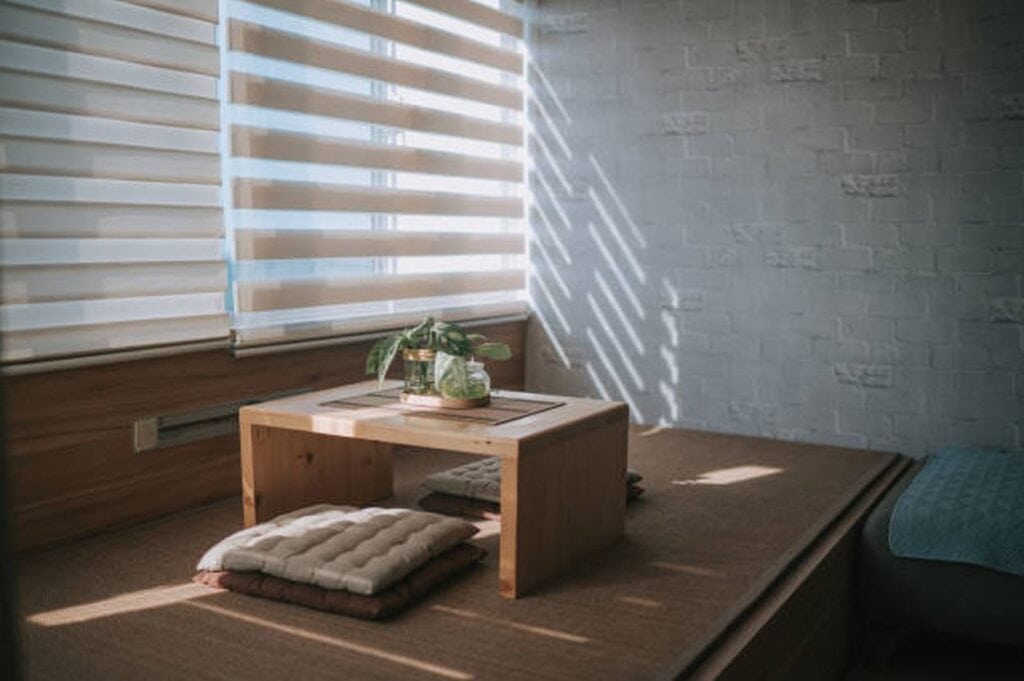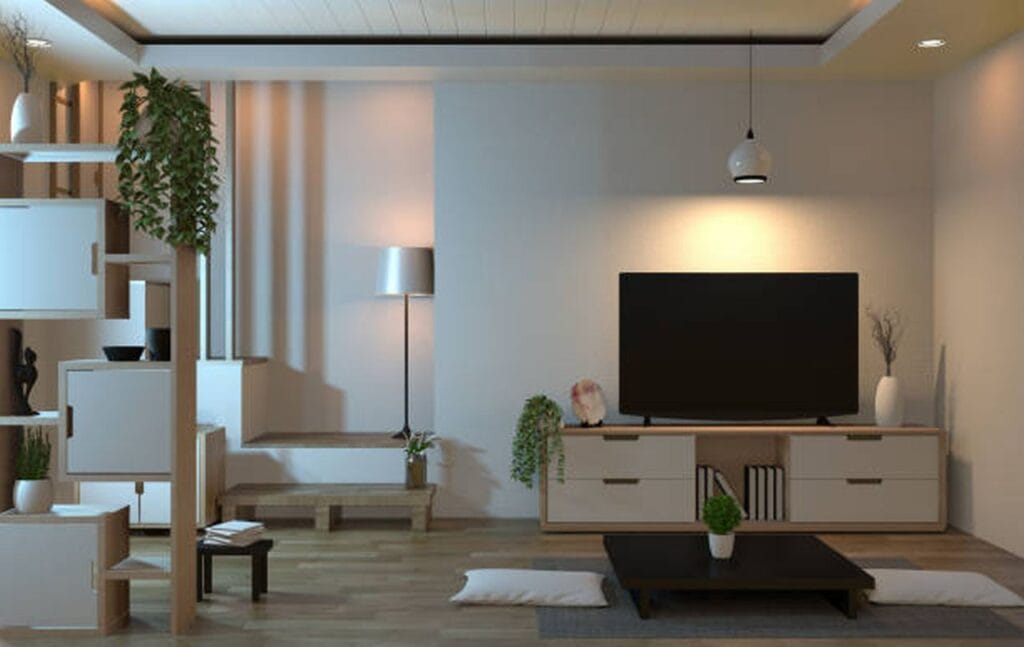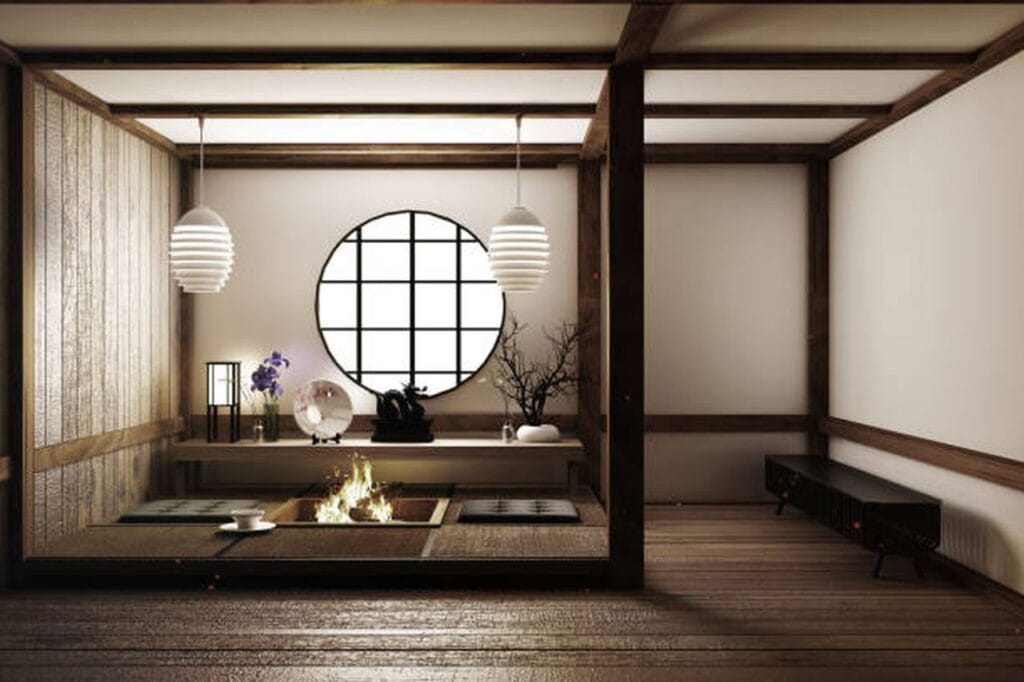Japanese interior design has a unique style. The decor has a relaxing effect on visitors because it is a reflection of local culture and customs.
Let's say you're interested in Japanese-inspired interior design and want to learn more about how to implement some of these concepts in your own home.
Japanese aesthetics are defined by a commitment to minimalism, symmetry, order, tradition, and a reverence for the natural world.
As soon as you learn about traditional Japanese tea rituals and daily life, you'll find that the Japanese way of life is charming and admirable. Let's adopt certain Japanese cultural practices in order to absorb some of their refined Zen into our daily lives. We could all use a little more domestic tranquillity, couldn't we?
The Japanese aesthetic is renowned for its elegance and sophistication, and we will demonstrate how to incorporate some of these elements into your house.
Probably more than any other culture, the Japanese have perfected the art of creating aesthetically pleasing and relaxing indoor environments. As a result, it's not surprising that contemporary international designers are increasingly borrowing elements of traditional Japanese aesthetics to help them cope with the stresses of the modern world.
Guests to Japan are often amazed by the minimalist elegance of traditional Japanese homes. Natural elements, however, are often subtly incorporated by Japanese designers into otherwise minimalist interiors.
Using minimalist concepts from Japanese design is a certain way to make your home feel more spacious. Here are some pictures to help you bring some Zen into your home.
Incorporate Elements Of Nature
Using elements of nature is essential to achieving the authentic look of Japanese interior design. Put another way, this is bringing the outdoors within. The easiest way to achieve this is to include bonsai, zen gardens, and other traditional Japanese flora such as bamboo and cherry trees. When bamboo is unavailable, any other type of foliage will do. Replace it with something green, like a palm tree or an orchid.
Keep in mind that the guiding principles of Japanese interior design are minimalism and understatement. Can you please be straightforward and unaffected? Use lots of natural light and a wide view by installing lots of windows. When it comes to Japanese interior design, nothing is more important than a sweeping view of the outdoors.
Fix A Soaking Tub
To complete your home's true Japanese aesthetic, you should install a soaking tub. Japanese for "bath" is "ofuro," and it is a crucial aspect of everyday life in Japan, so make the most of it by setting up a luxurious soaking tub in your home. It will make your bathroom the most relaxing space in the house (or even the house!).
Include Screens Or Sliding Doors
Shoji, a genuine Japanese screen, is a standard fixture in most Japanese residences. As a result of Japan's sky-high real estate prices, most people there are forced to make do with cramped studios or one-bedroom flats. Due to space constraints, they make every effort to minimise wasted motion. Sliding doors are used as a means of conserving energy. Sliding doors are a great alternative to swinging doors because of the amount of room they conserve.
In their traditional form, Japanese screens were made of paper that was both translucent and wooden. However, you can now purchase updated versions of these displays made out of glass panels on the internet. The fact that these screens let light and views into the room while doors do not is striking. To achieve the look and feel of a Japanese room, you can replace solid walls with sliding doors or screens.
Wood And Bamboo Can Be Added As Decoration.
When attempting to recreate authentic Japanese interior design, wood and bamboo are essential elements. You are not restricted in your application of either of these two. It's unusual to come across an Asian society that doesn't make extensive use of wood and bamboo. Wood can be used for the walls, ceiling, and floor, and it can be used to frame windows and doors. You can also use cypress or red pine wood for your flooring if you choose.
Bamboo is often used in Japanese architecture and interior design to bring the outside in. Enjoy the tranquil atmosphere that bamboo provides whether used as wall or floor decor. You can find some examples of wood and bamboo ornamentation below:
Use The Foyer In Japanese Style.
The Japanese entryway, known as the genkan, plays an important role in the design of traditional Japanese homes. When entering a home, guests are usually greeted in a foyer, where they can remove their shoes. In every Japanese entryway, you'll find a shelf known as a Getabako. Getakabo is a shoe rack used to maintain order and cleanliness.
If you want your front door to stand out, you may use a genkan like the Japanese do. There should be plenty of windows and wood accents throughout the room. To complement the foyer, stone tiles are a great option. Once more, you may achieve this lovely look by emulating Japanese design.
Make White The Dominant Colour
Let's say you've decided to go with a white colour scheme in your home in homage to classic Japanese design. White walls, furniture, and floors are OK. Keep in mind that the Japanese appreciate spaciousness and favour simple design, both of which are complemented by the colour white.
If white isn't your favourite colour, any neutral shade will do the trick in making the space feel more open. Colours are used to complement natural light, a tenet of Japanese design, which helps to keep the space looking uncluttered and fresh.
Try Using Tatami Mats
The Japanese are unusual in that they don't utilise the same kinds of baby furniture as Westerners do, such as high chairs and separate toddler beds. They use tatami mats for everything from sitting on the floor to sleeping on it. If you can't use a mat but still want some Japanese flair in your house, furnish low to the ground.
Make A Sand Zen Garden
If you enjoy spending time outside and appreciate the beauty of nature, a Zen garden may be a good fit for you. Incorporating this style into your home will not only give it a subtle Japanese flair, but will also help you relax and unwind. A little Zen garden can have the same calming effect as a larger one. Here is some inspiration for creating a Zen garden of your own.
Why Not Bring In An Aquarium
The element of water plays a vital significance in Japanese art and mythology because of the country's status as an island. Therefore, incorporating the element of water will be a huge help to Japanese culture. Further, it shows that you value their appreciation of the outdoors and the sea.
If you want a pond in your backyard complete with Koi fish, start looking at ideas. Alternatively, you may display Hokusai's iconic wave. If you're interested in learning more about creating a Koi pond in your landscape, you may do so by searching the term.
Favourite Woodblock Prints Should Be Hung
Woodblock prints are a great way to adorn your home's walls. The prints feature classic artworks in beautiful colours. Create your own one-of-a-kind print by sketching your favourite flower or miniature bonsai tree. View a nature-themed painting by Hokusai. The Japanese greatly like this ideal combination of nature and austerity.
Make A Space In Your Home For Meditation.
The scientific community has found proof that Zen monks have a firm grasp on the subject matter they discuss. Daily meditation has positive effects on both the body and the mind. It's important to keep in mind that self-meditating won't cost you anything. To do this, you need only choose a room in your house that is large enough to accommodate everyone in your family. When things get too stressful, it can help to have a quiet place to meditate.

Use Paper Lanterns To Light Up The Space
Paper lanterns have deep roots in Asian art and culture, particularly Japanese tradition. Candles were traditionally used to illuminate a room, but now there are attractive and risk-free electric alternatives. Here, we see that electric lamps have been used to create modern lanterns that go well with their surroundings.
Add More Open Space To The Area Around The House.
If you're going for that Japanese minimalist look, lots of empty space is a must. Having adequate room to spread out is therapeutic. In addition, the emphasis on nature in Japanese interior design is bolstered by a space that is less cluttered.
Decorate The Walls
Most Japanese homes have neutral-colored walls, such as brown or white. If you don't like it, just spice it up by hanging some artwork on the walls. Use any wall decals you like, but keep in mind that the Japanese aesthetic values simplicity. The removable stickers, which you can get online or in home improvement stores, shouldn't damage your walls in any way when removed.
Combining Japanese And Western Themes
Let's say you like the western aesthetic but also want to incorporate some Japanese elements. Throw a rug over low tables and use tatami mats for a more traditional Japanese feel. The result will be a blend of the two civilizations. Don't go crazy with the ornaments, though. When in doubt about whether your colour scheme is too bold, stick to the basics.
For Sofas, Use Floor Cushions
Use floor cushions in place of sofas to make the area appear more expansive. Zabuton are cushions for sitting on the floor, and they are often placed near a chabudai, a low folding table. The two can be used together when setting the table. Take a peek at how your living space could look with a Zabuton and chabudai set up.
Bonsai Trees
Bringing the outside in is a Japanese design priority, and a bonsai tree is a popular way to do just that. These green plants will cost more than their larger counterparts since they are more difficult to come by. Bonsai trees are a beautiful addition to any home, and their maintenance ensures that they will continue to do so. Your home could appear completely different when you add a bonsai tree.
Laundry Drying Corner
Laundry rooms are unusual in Japanese homes. This is also related to the fact that their structures are cramped. Therefore, you can select to create a compact drying nook. Although the drying nooks don't offer much in the way of ornamentation, they might be a nice touch for a stylish home. If you don't have any other ideas for a drying nook, you can always just copy this one or look for more online.
A Organised And Clean Closet
It's revolting to hang around in a dirty wardrobe. Your closet shouldn't look like a temple if you follow the principles of Japanese minimalism. Don't forget to put things in their proper places and get rid of clutter. Clean out your closet and find your best outfits among the items you've forgotten you owned.
Doing so can free up valuable closet space while also providing you with a fresh new look. The empty boxes in the picture are just one example of how you can personalise your storage space.
Your Walls Should Have Meaningful Calligraphy
The Japanese, like the Chinese, have a long history with the art of calligraphy. Song calligraphy is showcased artistically in a separate nook. If you want to learn how to create the pieces on your own, you could enrol in a calligraphy course. Click on the link to learn more about calligraphy.
Include Origami In Your Table Arrangement
Origami is another fun and easy way to bring some Japanese culture into your home. Put them in a creative pattern on the tables.
Invite your guests to join in the excitement by leaving them a set of instructions for a few simple projects. Putting out origami for guests to try to fix is a great way to keep the kids occupied while you eat. This is an example of an origami, so you can see how it appears.
Make Space For Natural Lighting
If memory serves, the Japanese have a penchant for nature and a penchant for simple design. Home interiors are more appealing and have a more natural feel when bathed in natural light. Make sure you have several skylights, windows, and other openings to let in as much natural light as possible.
Curtains should be kept light and airy, thus thick ones should be avoided. Additionally, any window coverings that may be blocking natural light should be removed. Choose bamboo blinds or sheers if you want lots of natural light to filter in.
Consider Blending Some Popular Japanese Colours.
The Japanese appreciate minimalism and orderliness, and they express these values through their choice of colour palettes. They use colour schemes inspired by nature to create a peaceful and relaxing atmosphere at home. Green represents vegetation, brown represents wood, and grey represents stone. Their floors are a stoney grey, and their furnishings are a warm brown. Always keep in mind that their walls are actually screens and that they favour dark paper.
You may rest assured that the aesthetic results you get with this design will meet your approval. Wooden closet rods, shelves, and floorboards are just a few examples. Then, to add even more vibrancy to your home, blend it with genuine green plants.
Why Not Utilise Stones To Create A Cooling Effect Within Your Home?
The natural beauty of stones can complement any design scheme. To create a relaxing atmosphere in your home, combine stone tiles with wooden panels. As can be seen below, you have the option of combining the two in specific spaces, such as the bathroom.

Natural Elements In Japanese Interior Design
The Japanese people have a deep and abiding reverence for the natural world. The best method to keep your connection with nature intact is to create an indoor garden.
Your home will have a little more Japanese flavour if you decorate with bonsai and bamboo, two plants that are considered to be culturally significant in Japan. Any dense foliage will work to create a similar effect. You might decorate your house with some classy palm trees or orchids. If you want to impress your Japanese hosts, don't go overboard with elaborate flower arrangements; instead, stick to something natural, unfussy, and leafy.
Another way that Japanese houses invite the outdoors in is with their voluminous windows, which provide a panoramic view of the landscape. Plus, the wide glass sliding door draws the outdoors in, like in this bedroom. So, this is the day to let nature's beauty in.
Soaking Tubs Are Important In Japanese Interior Design
The soothing sounds of running water will fill your ears as you meditate, providing an instant sense of serenity. Similarly to how plants are essential in a Western home, water features are considered a need in a Japanese one.
The Japanese bath, known as an ofuro, is a relaxing addition to any home. Small and deep, Japanese soaking tubs typically feature built-in bench seating. Those concerned with their health are gravitating to this Eastern fad, which features these tubs.
Installing one of these tubs in your bathroom will instantly transform it into a tranquil oasis. It's the pinnacle of fusing Eastern and Western aesthetics to make your house feel like a luxurious spa.
Conclusion
Decorating your home with artefacts and artwork from Japan is a terrific way to give it a refined, sophisticated air. It may seem overwhelming at first, but with a little bit of work, you can transform your room into something very beautiful and distinctive by implementing just a few of these easy ideas. With any luck, this post has provided you with some ideas for your next home improvement undertaking. Don't be hesitant to get in touch with us if you have any questions or would need any assistance in getting started.
FAQs About Home Decor
Japanese homes are usually decorated in natural colours, derived from the browns of wooden elements and the greens of plants.
Grey and neutrals are widely used everywhere in the rooms, resulting in a calming, soothing modern space. Don’t forget houseplants to bring more nature inside.
Modern Japanese interior design is anchored in minimalist principles, clean lines, and natural materials. With modern Japanese-style rooms, you’ll see simple, often low furniture, blank walls, and a neutral colour palette. In modern Japanese-style homes, less is more.
Japanese decor is arguably the most acceptable form of decoration known to the world, both aesthetically and spiritually. The neutral and natural colours, and geometric order of Japanese decor, lend a feeling of openness and purity seldom matched in other forms of decor.
They use the wabi-sabi interior design concept to internalise the idea of living with the world’s imperfections. They use hand-woven straw mats called Tatami mats. These are used to line the flooring of a Japanese house.
Japanese furniture relies on natural materials such as bamboo, fine woods, silk, rice straw mats, and paper. It blends modern elements with traditional Japanese design in an artful manner. The result is furniture that is simple, comfortable, and flexible.

